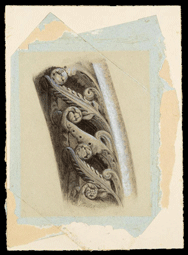Three Studies of Carving; Amiens and Rouen Cathedrals
Frank Randal (1852-1917) Watercolour and bodycolour on paper, 1882.
ArtistFrank Randal (1852-1917) was born in Paddington, London, to Charles Hayter Randal and Frances (née Arnold). Little is known of Randal, but Ruskin commissioned more works from him than any other artist in the Ruskin Collection. He caught the attention of Ruskin in 1881. He started to commission work from Randal, and this continued until 1887. Over this time, he produced at least 137 drawings and watercolours for the Guild.Randal later worked for Sir Sydney Cockerell, painting architectural records for the Society for the Preservation of Pictorial Records of Ancient Works of Art and painting commissions. This included a number for a prominent Sheffield art collector, George Parkes Wall, who was founder of the Pluto Steelworks.Randal had a brother Charles (described in the 1881 census as a photographer, and in the 1891 census as an artist and sculptor), and a sister, Fanny Scott Randal. A sketch of W. G. Collingwood, Ruskin and Randal was drawn on a letter that Charles sent to Fanny.
Ruskin on the Northern CathedralsIn Modern Painters V (1860), Ruskin explains the basis for what would be an enduring interest in the cathedrals of northern France and England:'The only art work that France and England have done nobly is that which is centralized by the Cathedral of Lincoln, and the Sainte Chapelle. We had at that time (we -- French and English -- but the French first) the incontestable lead among European nations; no thirteenth-century work in Italy is comparable for majesty of conception, or wealth of imaginative detail, to the Cathedrals of Chartres, Rheims, Rouen, Amiens, Lincoln, Peterborough, Wells, or Lichfield. But every hour of the fourteenth century saw French and English art in precipitate decline, Italy in steady ascent;' (Works, 6, p. 436). Ruskin on AmiensRuskin considered Amiens 'the Venice of the North' (Works, 33. p. 5). Collection of the Guild of St George, Museums Sheffield
Sources of interest included the statues of the Apostles in the Central Porch of the West Front, and the life of St Firmin, the local patron saint. St Firmin was beheaded in the city, and his remains subsequently venerated. In later life, Ruskin published The Bible of Amiens (1880-5), a study of the cathedral that was meant to form one of a series of 'Sketches of the History of Christendom for Boys and Girls who have been Held at its Fonts'.
Ruskin on RouenRuskin's relationship with Rouen stretched back to the Continental tours of his youth. A letter from there written to his father in 1848 gives an impression of the city's formative influence: 'I still feel', he laments, 'that I leave this place Unseen; this is partly, however, owing to my slowness in taking in; I cannot grasp it. Every time I walk into the Square it is new to me. Still I verily believe that I now know more about it than any English architect, and than most French, and I have improved in my drawing in these three months considerably; the different style of Gothic quite beat me at first, and still it does in a great degree.' (Works, 8, p. xxxii).Ruskin later wrote that Rouen was 'a city altogether inestimable for its retention of mediaeval character in the infinitely varied streets in which one half of the existing and inhabited houses date from the fifteenth or early sixteenth century, and the only town left in France in which the effect of old French domestic architecture can yet be seen in its collective groups' (Works, 12, p. 427). |



















